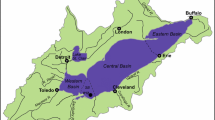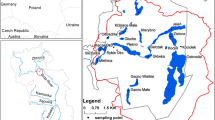Abstract
Sources and distribution of major and trace elements were investigated in the Plitvice Lakes, a pristine cascade hydrological system of sixteen karst lakes situated in a sparsely populated area of the central Croatia. Water and surface sediment samples from 17 locations, including springs, tributaries and lakes, were analyzed for the content of 22 elements by high-resolution inductively coupled mass spectrometry. Principal component analysis of the collected data set showed that different springs and tributaries displayed distinct multielemental compositions, reflecting primarily the differences in their corresponding geological backgrounds. It was shown that the springs situated in the Upper and Middle Jurassic dolomite bedrock represented the main source of several trace elements, including some toxic metals (Cd, Zn, Ni and Tl), to the Plitvice Lakes system. The concentrations of most of the trace elements (Mn, Fe, Al, Cd, Zn, Cu, Ni, Pb, Co, Cr and Tl) showed decreasing spatial trends in the downstream direction, from sources to the lakes. Such a distribution was interpreted to be a consequence of an efficient removal of the dissolved elements in the lentic parts of the system, mainly by co-precipitation with authigenic calcite and Mn oxides. Nevertheless, most of the elements in the lake sediments were highly correlated with Al, which indicated their prevalent association with terrigenic material. It was shown that the multicascade system of the Plitvice Lakes had an enhanced autopurification efficiency regarding the elimination of most of the trace metals from the aqueous phase.





Similar content being viewed by others
References
Babinka S (2008) Environmental isotopes as a tool for hydrological characterization of karst aquifer, groundwater protection and estimation of groundwater reserves. Case study: Plitvice Lakes and Bihać area. In: Ožanic N (ed) Proceedings of the conference on measurements and data processing in hydrology. Plitvice Lakes National Park, pp 231–246
Barešić J (2009) Application of isotopic and geochemical methods in the study of global and local changes in ecological system of Plitvice Lakes, PhD thesis, University of Zagreb, (in Croatian)
Barešić J, Horvatinčić N, Roller-Lutz Z (2011) Spatial and seasonal variations in the stable C isotope composition of dissolved inorganic carbon an in physico-chemical water parameters in the Plitvice Lakes system. Isot Environ Health S 47:316–329
Bindler R, Renberg I, Rydberg J, Andren T (2009) Widespread waterborne pollution in central Swedish lake and the Baltic Sea from pre-industrial mining and metallurgy. Environ Pollut 157:2132–2141
Biondić B, Biondić R, Meaški H (2010) The conceptual hydrogeological model of the Plitvice Lakes. Geol Croat 63:195–206
Camarero L, Botev I, Muri G, Psenner R, Rose N, Stuchlik E (2009) Trace elements in alpine and arctic lake sediments as a record of diffuse atmospheric contamination across Europe. Freshw Biol 54:2518–2532
Chada VGR, Hausner DB, Strongin DR, Rouff AA, Reeder RJ (2005) Divalent Cd and Pb uptake on calcite 1014 cleavage faces: an XPS and AFM study. J Colloid Interface Sci 288:350–360
Covelli S, Fontolan G (1997) Application of a normalization procedure in determining regional geochemical baselines. Environ Geol 30:34–45
Cukrov N, Frančišković-Bilinski S, Mikac N, Roje V (2008) Natural and anthropogenic influences recorded in sediments from the Krka river estuary (Eastern Adriatic coast), evaluated by statistical methods. Fres Environ Bull 17:855–863
Cukrov N, Kwokal Ž, Lojen S, Mikac N (2011) Distribution of metals and stable isotopes O and C in laminar tufa from Plitvice lakes. In: Šutić M (ed) Proceedings of the meeting “60 years of the National Park Plitvice”. Plitvice Lakes National Park, October 2009, pp 288–294 (in Croatian)
De Bartolomeo A, Poletti L, Sanchini G, Sebastiani B, Morozzi G (2004) Relationship among parameters of lake polluted sediments evaluated by multivariate statistical analysis. Chemosphere 55:1323–1329
Elzinga EJ, Reeder RJ (2002) X-ray absorption spectroscopy study of Cu2+ and Zn2+ adsorption complexes at the calcite surface: implications for site-specific metal incorporation preferences during calcite crystal growth. Geochim Cosmochim Acta 22:3943–3954
EPCEU (European Parliament and the Council of the European Union) (2008) Directive 2008/195/EC of the European Parliament and of the Council on environmental quality standards in the field of water policy
Fiket Ž, Roje V, Mikac N, Kniewald G (2007) Determination of arsenic and other trace elements in bottled waters by high resolution inductively coupled plasma mass spectrometry. Croat Chem Acta 80:91–100
Gaillardet J, Veirs J, Dupre B (2003) Trace elements in river water. In: Drever JI (ed) Volume 5. Surface and groundwater, weathering and soils. In: Holland HD, Turkein KK (eds) Treatise on geochemistry. Elsevier, Amsterdam, vol 5.09, pp 225–272
Horvatinčić N, Brianso JL, Obelić B, Barešić J, Krajcar Bronić I (2006) Study of pollution of the Plitvice Lakes by water and sediment analyses. Water Air Soil Poll Focus 6:475–485
Horvatinčić N, Barešić J, Babinka S, Obelić B, Krajcar-Bronić I, Vreča P, Suckow A (2008) Towards a deeper understanding of how carbonate isotopes (14C, 13C, 18O) reflect environmental changes: a study with recent 210Pb dated sediments of the Plitvice Lakes, Croatia. Radiocarbon 50:233–253
Koschinsky A, Hein JR (2003) Uptake of elements from seawater by ferromanganese crusts: solid-phase associations and seawater speciation. Mar Geol 198:331–351
Lalor GC, Zhang CS (2001) Multivariate outlier detection and remediation in geochemical databases. Sci Total Environ 281:99–109
MacDonald DD, Ingersoll CG, Berger TA (2000) Development and evaluation of consensus-based sediment quality guidelines for freshwater ecosystems. Arch Environ Contam Toxicol 39:20–31
Martinez CE, Yanez C, Yoon SJ, Bruns MA (2007) Biogeochemistry of metalliferous peats: sulfur speciation and depth distributions of dsrAB genes and Cd, Fe, Mn, S and Zn in soil cores. Environ Sci Technol 41:5323–5329
Mikac N, Branica M (1994) Wet deposition of ionic alkyllead compounds and total lead in urban areas of Croatia. Atmos Environ 28:3171–3179
Mikac I, Fiket Ž, Terzić S, Barešić J, Mikac N, Ahel M (2011) Chemical indicators of anthropogenic impacts in sediments of the pristine karst lakes. Chemosphere 84:1140–1149
Pacyna JM, Pacyna EG (2001) An assessment of global and regional emission of trace metals to the atmosphere from anthropogenic sources worldwide. Environ Rev 9:269–298
Pokrovsky OS, Dopre B, Schott J (2005) Fe-Al-organic colloids control of trace elements in peat soil solutions: results of ultrafiltration and dialysis. Aquat Geochem 11:241–278
Quezada-Hinojosa RP, Matera V, Adatte T, Rambeau C, Follmi KB (2009) Cadmium distribution in soils covering Jurassic ootlitic limestone with high Cd contents in the Swiss Jura. Geoderma 150:287–301
Sigg L, Sturm M, Kistler D (1987) Vertical transport of heavy metals by settling particles in Lake Zurich. Limnol Oceanogr 32:112–130
Srazmek K, McIntosh JC, Williams EL, Kanduč T, Ogrinc N, Walter LM (2007) Relative weathering intensity of calcite versus dolomite in carbonate-bearing temperate zone watershed: carbonate geochemistry and fluxes from catchment within the St. Lawrence and Danube rivers basins. Geochem Geophys Geosyst 8:1–26
Srdoč D, Obelić B, Horvatinčić N, Krajcar-Bronić I, Marčenko E, Merjt J, Wong HK, Slijepčević A (1986) Radiocarbon dating of lake sediments from two karst lakes in Yugoslavia. Radiocarbon 28:459–502
Srdoč D, Horvatinčić N, Ahel M, Giger W, Schaffner C, Krajcar Bronić I, Petricioli D, Pezdić J, Marčenko E, Plenković-Moraj A (1992) Anthropogenic influence on the 14C activity and other constituents of recent lake sediments: a case study. Radiocarbon 34:585–592
Suturin AN, Paradina LF, Epov VN, Semenov AR, Lozhkin VL, Petrov LL (2003) Preparation and assessment of a candidate reference sample of Lake Baikal deep water. Spectrochim Acta Part B 58:277–288
Tang Y, Elzinga EJ, Lee YJ, Reeder RJ (2007) Coprecipitation of chromate with calcite: batch experiments and X-ray absorption spectroscopy. Geochim Cosmochim Acta 71:1480–1493
Thevenon F, Guedron S, Chiaradia M, Loizeau JL, Pote J (2011) (Pre-) historic changes in natural and anthropogenic heavy metals deposition inferred from two contrasting Swiss Alpine lakes. Quaternary Sci Rev 30:224–233
Tribovillard N, Algeo TJ, Lyons T, Riboulleauu A (2006) Trace metals as paleoredox and paleoproductivity proxies: an update. Chem Geol 232:12–32
Veizer J, Demovič R (1974) Strontium as a tool in facies analysis. J Sed Petrol 44:93–115
Velić I, Vlahović I (2009) Explanation of the Croatian Geological Map 1:300.000 Croatian Geological Survey, Zagreb, p 141
Wedepohl KH (2004) The composition of Earth’s upper crust, natural cycles of elements, natural resources. In: Merien E, Anke M, Inhat M, Stoeppler M (eds) Elements and their compounds in the environment, vol 1., General AspectsWiley-VHC Verlag Gmbh & Co. KGaA, Weinheim, pp 3–16
Zachara JM, Cowan CE, Resch CT (1991) Sorption of divalent metals on calcite. Geochim Cosmochim Acta 55:1549–1562
Zaharescu D, Hooda PS, Soler AP, Fernandez J, Burghelea CI (2009) Trace metals and their source in the catchment of the high altitude Lake Respomuso, Central Pyrenees. Sci Tot Environ 407:3546–3553
Acknowledgments
The work was supported by the Ministry of Science, Education and Sport of the Republic of Croatia. Financial support from the Royal Norwegian Ministry of Foreign Affairs to the project “Mitigation of environmental consequences of the war in Croatia—risk assessment of hazardous chemical contamination” is gratefully acknowledged.
Author information
Authors and Affiliations
Corresponding author
Electronic supplementary material
Below is the link to the electronic supplementary material.
Rights and permissions
About this article
Cite this article
Dautović, J., Fiket, Ž., Barešić, J. et al. Sources, Distribution and Behavior of Major and Trace Elements in a Complex Karst Lake System. Aquat Geochem 20, 19–38 (2014). https://doi.org/10.1007/s10498-013-9204-9
Received:
Accepted:
Published:
Issue Date:
DOI: https://doi.org/10.1007/s10498-013-9204-9




